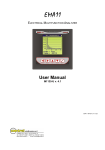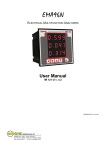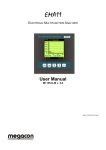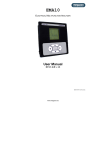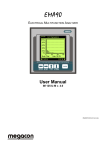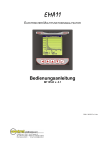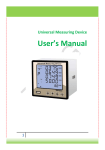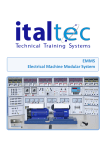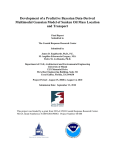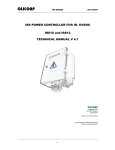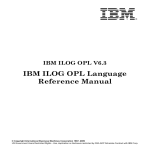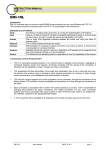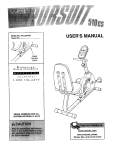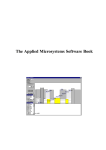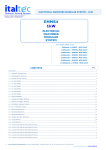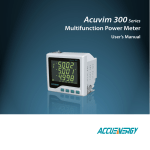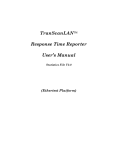Download EMA-D9 - Contrel elettronica
Transcript
EMA-D9 ELECTRICAL MULTIFUNCTION ANALYZER User Manual IM 115-U v. 3.4 EMAD9 IM115-U v3.4.doc EMA-D9 - USER MANUAL Information in this document is subject to change without notice and does not represent a commitment on the part of Contrel Elettronica Srl. This documentation is consigned to the customer to enable the correct and safe operation of the instrument; any other use of documentation is strictly prohibited. The information contained herein is the property of Contrel Elettronica Srl, and by law, no part of it may be reproduced, transcribed, stored in any retrieval system, or translated into any language by means (even for internal purposes by the customer) without the express written permission of Contrel Elettronica Srl. In addition, no part of this manual may be transmitted in any form by any means, including photocopying and recording, for any purposes, without the express written permission of Contrel Elettronica Srl. In case of Copyright violation the customer is directly responsible. TERMS OF WARRANTY The warranty is valid for the period of twelve months after material receipt. The warranty covers free repair or replacement of equipment parts, which are recognized as faulty due to manufacturing defects. Warranty does not cover those parts which results defective due to misuse or improper use, incorrect installation or maintenance, operation by unauthorized personnel, damage during transportation, or which in any case do not show manufacturing defects of the equipment. Not included in the warranty terms are technical interventions regarding equipment installation to electrical systems. The manufacturer declines any responsibility for eventual injury or damage to persons, animals or things as result of failure to follow the instructions in the user manual or caused by improper use of equipment. Warranty covers equipment returned ex works. The expenses of transport as well as the relative risks of same both to and from the place of repair, will be the sole responsibility of the user. This warranty expires after the date of purchase and any assistance required after said date including spare parts, labour, transport of personnel and material will be charged to the user following the tariffs in force for Technical Assistance Service at the time of such requested service. In any case the replacement of the equipment as well as the extension of warranty after such breakdown is excluded. -2- EMA-D9 - USER MANUAL INDEX 1) MAIN INFORMATION _________________________________________________________5 1.1) INTRODUCTION _________________________________________________________5 1.2) DESCRIPTION ___________________________________________________________5 1.3) CE CONFORMITY AND STANDARDS ________________________________________5 2) TECHNICAL FEATURES ______________________________________________________6 2.1) GENERAL SPECIFICATIONS_______________________________________________6 2.2) MEASURING METHOD AND ACCURACY_____________________________________8 2.3) PROGRAMMABLE PARAMETERS (SETUP SECTION) __________________________8 2.4) MEASURED VARIABLES __________________________________________________9 2.5) CALCULATED VARIABLES ________________________________________________9 2.6) MEASURING & CALCULATION FORMULAS _________________________________10 3) INSTRUMENT DESCRIPTION _________________________________________________12 4) INSTALLATION ____________________________________________________________13 4.1) SAFETY _______________________________________________________________13 4.2) OPERATOR SAFETY ____________________________________________________13 4.3) MOUNTING ____________________________________________________________13 5) INTERNAL BATTERY________________________________________________________14 5.1) 6) REPLACEMENT OF THE INTERNAL BATTERY_______________________________14 CONNECTION______________________________________________________________15 6.1) POWER SUPPLY________________________________________________________16 6.2) VOLTAGE INPUTS ______________________________________________________16 6.3) CURRENT INPUTS ______________________________________________________16 6.4) WIRING DIAGRAMS _____________________________________________________17 7) INPUT/ OUTPUT DEVICES ___________________________________________________20 7.1) STANDARD DIGITAL INPUTS _____________________________________________20 7.2) DIGITAL INPUTS (option)_________________________________________________21 7.3) STANDARD DIGITAL OUTPUTS ___________________________________________22 7.4) SERIAL OUTPUTS ______________________________________________________23 7.4.1) RS485 CONNECTION NOT SHIELDED __________________________________23 7.4.2) RS 485 CONNECTION SHIELDED ______________________________________24 7.4.3) RS232 CONNECTION ________________________________________________24 7.4.4) MODEM CONNECTION _______________________________________________25 -3- EMA-D9 - USER MANUAL 7.4.5) 8) SECOND RS485 BOARD (option) ______________________________________25 USE ______________________________________________________________________26 8.1) 9) FUNCTION KEYS _______________________________________________________26 REAL TIME VALUES ________________________________________________________26 9.1) VISUALIZATION TREE ___________________________________________________27 9.2) VISUALIZATION MEASURES______________________________________________29 9.3) STATUS AND INFORMATION PAGES ______________________________________36 10) SETUP ____________________________________________________________________38 10.1) MAIN MENU SETUP _____________________________________________________39 10.2) GENERAL _____________________________________________________________40 10.3) SERIAL COMM _________________________________________________________41 10.4) AVERAGE _____________________________________________________________42 10.5) ENERGY ______________________________________________________________42 10.6) STORAGE _____________________________________________________________45 10.7) DIGITAL OUTPUT _______________________________________________________47 10.8) DIGITAL INPUT _________________________________________________________48 10.9) ANALOG OUTPUT (option available only with external module) ________________50 10.10) RESET ______________________________________________________________51 10.11) EXIT SETUP __________________________________________________________51 11) PROBLEMS AND SOLUTIONS ________________________________________________52 12) EMA SERIAL COMMUNICATION PROTOCOL____________________________________53 13) Notes _____________________________________________________________________53 -4- EMA-D9 - USER MANUAL 1) MAIN INFORMATION 1.1) INTRODUCTION EMA-D9 was engineered and tested in compliance with IEC 348 class 1 standard for operating voltages up to 600 Vac rms, considering the VDE 0110 group C isolation standards for operating voltages up to 500 Vac rms. The present manual contains all of the information warnings that must be followed up by the operator to ensure a right use of the equipment and to maintain the safe operating conditions. 1.2) DESCRIPTION The EMA-D9 is an instrument which has been designed to monitor, store and analyze all electrical variable in a distribution line. All the relevant data are displayed and, if desired, stored on internal RAM and transmitted to a remote PC, via RS485 (standard) on which the compatible management software has been installed. It is possible to monitor via digital outputs (2 dig. out. standard) alarms, sirens or strategically factory loads. EMA-D9 with optional harmonic analyzes can carry out network harmonic content analyzes with FFT method up to the 31st harmonic, very useful to locate network disturbances. The EMA can perform accurate deep and complete energy analyzes. A fundamental feature of EMA-D9 is the easy way to integrate new additional options and the upgrading of the firmware using serial port and flash technology. All parameters are displayed on a backlit alphanumeric LCD display of 2x20 characters. Displaying and programming mode are carried out by means of a 5 buttons keyboard. 1.3) CE CONFORMITY AND STANDARDS The instrument was tested in compliance with EMC 89/336/EEC and complies with the following standards: EMISSIONS = EN 50081-1 1992 - EN 55022-CLASS B CISPR 22 IMMUNITY = EN 50082-1 (light industry), 1992 IEC 1010-2 IEC 1036 (cl.1) -5- EMA-D9 - USER MANUAL 2) TECHNICAL FEATURES 2.1) GENERAL SPECIFICATIONS Power supply / Auxiliary voltage 90-250 V 50/60 Hz/cc. 20-60 V 50/60 Hz/cc (option). Isolation voltage 3700 Vac rms x 1 minute. Voltage input 3 inputs, range 10-600Vrms between phase-phase. Over voltage up to 750 Vac permanent, beyond this value it is imperative to use voltage transformers. Over voltage category: III (fixed installation) Pollution degree: 2 (normally not conductive; temporary conductive for condensation) Resistor input: >2 MΩ. Burden 0.2 VA. Current input 3 isolated inputs (internal CT) range Over current max Model EMA-D9 10mA-5A rms 10A (100A for 1 second) Model EMA-D9-1A 4mA-1A rms 2A (10A for 1 second) Consumption 4VA typical. 6VA max, full optional. Serial output RS485/RS232 (configurable on board), half duplex isolated, signals Tx/Rx, Gnd. Programmable baud rate from 1.200 to 19.200 bps. Protocols: ASCII and Modbus. Second serial output RS485 isolated (optional). Input signals 2 passive opt isolated inputs (1000V), 12 - 24 Vdc. 4 passive opt isolated inputs (1000V), 12 - 24Vcc (option). Output signals 2 photomos outputs 12-260 Vca-cc / 100mA max (series). Memory data retention RAM: 128 KB (useful 50KB); 1 Mbyte (all useful) option. No volatile memory data using internal battery. Data retention: 5 years (typical) at +25°C (77°F). Stored variables: Average power, Min/max values, Harmonics (option), Energy, Samples. Display interface Alphanumeric LCD 2x20 characters at high contrast (adjustable) and with led backlight. Keyboard interface 5 functional keys for paging and programming. -6- EMA-D9 - USER MANUAL Operating temperature From -10°C (14°F) to +50°C (122°F). Storage temperature From -15°C (5°F) to +70°C (158°F). Operating humidity 90% not condensing. Protection standards IP 42 front (EN60529). IP 20 behind. Weight and dimension 0,5 kg app. (equipped with 2 digital outputs, 2 digital inputs, RS485 and RS232, Memory 128Kbytes), 9 module (17,5mm) case, for mounting on DIN 35mm section iron. X 33 158 48 78 -7- 62 T 45 ENTE R 90 S W EMA-D9 - USER MANUAL 2.2) MEASURING METHOD AND ACCURACY Measuring range 30-500Hz. Measuring method 64 sampling per period for V1 and I1, V2 and I2, V3 and I3. Measuring interval 0,1 second. Instrument accuracy Voltage: < 0.5 % Current: < 0.5 % Power: < 1 % Energy: < 1 % Power Factor: < 1 % Sampling frequency 45 Hz=2.280 or at 60 Hz = 3,88kHz Zero self-regulation Offset 0,1 second. RTC - REAL TIME CLOCK Accuracy: 5 PPM 2.3) PROGRAMMABLE PARAMETERS (SETUP SECTION) VT and CT ratio. Mode, insertion type (4 wires, 3 wires, Aron). Integration time of Av. power. Sampling frequency. Address or logical number of equipment. Date and time. Time-bands of power consumption in different periods. Storage section (Min/max, Harmonics, average power and Sampling values). All parameters concerning the input/output section (serial port, analog output, digital input and output). Preset energy counters. -8- EMA-D9 - USER MANUAL 2.4) MEASURED VARIABLES PHASE VOLTAGE (Rms) LINE CURRENT (Rms) FREQUENCY TEMPERATURE VL1-N - VL2-N - VL3-N IL1 - IL2 - IL3 FL1 (Hz) T(°C) 2.5) CALCULATED VARIABLES LINE VOLTAGE (Rms) THREE-PHASE SYSTEM VOLTAGE (Rms) VL1-L2 - VL2-L3 - VL3-L1 V THREE-PHASE SYSTEM CURRENT (Rms) AVERAGE THREE-PHASE SYSTEM CURRENT MAXIMUM AVERAGE THREE-PHASE SYSTEM CURRENT AVERAGE LINE CURRENT MAXIMUM AVERAGE LINE CURRENT NEUTRAL CURRENT AVERAGE NEUTRAL CURRENT MAXIMUM AVERAGE NEUTRAL CURRENT I Iavg Imaxavg IL1avg-IL2avg-IL3avg IL1maxavg - IL2maxavg - IL3maxavg IN INavg INmaxavg POWER FACTOR THREE-PHASE SYSTEM POWER FACTOR PFL1 - PFL2 - PFL3 PF COSϕ THREE-PHASE SYSTEM COSϕ COSϕ L1, COSϕ L2, COSϕ L3 COSϕ APPARENT POWER THREE-PHASE SYSTEM APPARENT POWER ACTIVE POWER THREE-PHASE SYSTEM ACTIVE POWER REACTIVE POWER THREE-PHASE SYSTEM REACTIVE POWER AVERAGE ACTIVE POWER AVERAGE REACTIVE POWER SL1 - SL2 - SL3 (VA) S (VA) PL1 - PL2 - PL3 (W) P (W) QL1 - QL2 - QL3 (VAr) Q (VAr) Pavg (W) Qavg (VAr) THREE-PHASE SYSTEM ACTIVE ENERGY THREE-PHASE SYSTEM TRANSFERRED ACTIVE ENERGY THREE-PHASE SYSTEM INDUCTIVE REACTIVE ENERGY THREE-PHASE SYSTEM CAPACITIVE REACTIVE ENERGY Total counters and time bands are available. Wh+ WhVArh+ VArh- TOTAL HARMONIC DISTORTION - THD (%) CURRENT AND VOLTAGE HARMONIC ANALYZES (Option) Analyzes up to the 31st harmonic of both voltage and current for each phase. VL1-N, VL2-N, VL3-N; IL1, IL2, IL3 (%) -9- EMA-D9 - USER MANUAL 2.6) MEASURING & CALCULATION FORMULAS P Phase Voltage RMS ∑ v 2LiN k k =1 V LiN = P P Line Current RMS ∑ i 2LiN k k =1 I Li = P P Active Power W Li = ∑ vL k ⋅iL k i iN k =1 P P = ∑ v L k ⋅ i L (k − ∆) i iN k =1 Reactive Power Q Appearent Power A Li = V LiN ⋅ I LiN Cosϕ cos ϕ Li Power Factor PF Li = Active Energy ∞ = Wh Li ∫ W Lidt 0 Li P = W Li 2 W 2L + Q L i i W Li A Li -10- EMA-D9 - USER MANUAL Reactive Energy Qh ∞ = ∫ Q dt Li Li 0 P Line Voltage V L ij = 3 - Phase Line Voltage V 3Φ = 3 - Phase System Current 3 - Phase Active Power 3 - Phase Reactive Power 3 - PhaseAppea rent Active Energy Reactive Energy ∑ v 2Lij k k =1 P V L12 + V L 23 + V L 32 3 I L1 + I L 2 + I L3 3 W 3Φ = W L1 + W L2 + W L3 Q3Φ = Q + Q + Q L1 L2 L3 A3Φ = A L1 + A L2 + A L3 ∞ = Wh 3Φ ∫ Wh 3Φdt 0 ∞ Qh 3Φ = ∫ Qh 3Φdt 0 I 3Φ = Harmonic analyzes: Cooley - Tukey algorithm. H(k) = N−1 N−1 2 πnk 2 πnk ∑ h(n) cos − j ∑ h(n) sin N N n = 0 n = 0 for 0 ≤ k ≤ N - 1 N = 64 -11- EMA-D9 - USER MANUAL 3) INSTRUMENT DESCRIPTION The front panel of the EMA-D9 is described on the following section: 1-DISPLAY Alphanumeric LCD backlighting, 2x20 characters, dot pitch 0.65mm x 0.70mm, dot size 0.60mm x 0.65mm, angle of view 35°, positive visualization at low reflection. 2-KEYBOARD In the “Acquisition Mode” the "up", "down", “left” and “right” arrows allows to skip through the measuring page of the instrument. Pressing the "Enter" key for 3 seconds set the displayed page as default page. The “Enter” key allows also to display the name of the page showed. In the “Setup Mode” all the buttons are used to program the instrument. 3- LOWER TERMINAL BOARD The lower terminal board is numbered from 1 to 27 (from left). 4- HIGHER TERMINAL BOARD The higher terminal board is numbered from 28 to 54 (from left). For the pin-out of the terminal boards see the chapter Cap. 6). -12- EMA-D9 - USER MANUAL 4) INSTALLATION 4.1) SAFETY On receipt of the instrument and prior to installation, make sure it is intact and has not been damaged during shipment. Before installing, make sure the operating voltage and mains voltage are compatible. The instrument power supply must not be earthed. The instrument is equipped with a fuse on the power supply type: 5x20mm 315mA 250V Fast (es. Schurter FSF). • • • • Always disconnect the instrument from all power sources before opening it for maintenance a/or repairs. The instrument's capacitor may still be charged even after it has been disconnected from all power sources. Maintenance and/or repairs must only be carried out by qualified and authorized personnel. If in any doubt about the instrument's safety take it out of service and implement the necessary procedures to prevent its inadvertent use. • Instrument operation is no longer safe: A) when the instrument shows clear signs of damage. B) when the instrument does not work. C) after long storage in extreme conditions. D) after serious damage during shipment. 4.2) OPERATOR SAFETY Carefully read the following pages before installing and using the purchased instrument. Maintenance and/or repairs must only be carried out by qualified and authorized personnel. To ensure proper and safe use of the instrument and its correct maintenance and/or repairs, authorized personnel must follow normal safety procedures at all times. SYMBOLS ! READ CAREFULLY THE CONTAINED INSTRUCTIONS 4.3) MOUNTING The instrument is suitable for mounting on DIN 35mm section iron. For the connection the instrument has suitable screw terminal boards. Suggested is to install the equipment on vibration free switchboards and with an environmental temperature ranging between -10 °C and +50°C. -13- EMA-D9 - USER MANUAL 5) INTERNAL BATTERY To avoid to lose the setup and all storing data, the instrument is equipped of an internal battery (CR2450). 5.1) REPLACEMENT OF THE INTERNAL BATTERY Only a qualified and authorized technical person can change the internal battery. This operation will delete all storing data and it will restore the default setup with the exception of the password and the code to enable the harmonics and time bands. Using the software NRG (or relative serial commands) it’s possible to download all storing data to avoid to losing same. The battery is located on the lower side of the circuit with push button. HOLE A NUTS HOLE B Instruction to change the internal battery: 1) It’s necessary to cut off the power supply of instrument and to disconnect all inputs and all outputs. 2) Remove the protection cap of the instrument. It’s necessary to incline the protection cap from 45° to 90° respect the closing position and to pull it in the direction of the user. Initially come out the left part and after the right part. 3) Remove the badge, spreading out the longer borders of the cage in the way to insert a flat screwdriver between the border and the badge and to lever up. 4) It’s necessary to pay attention to presence of residual voltage inside the instrument. Don’t touch any other component different from the battery circuit. 5) Using a pipe spanner (5,5mm) unscrew the 4 nuts showed in the picture. 6) Unthread the boards with push button to pull it in the direction of user. It’s better to insert a plier in the 2 holes (A and B) of the board. 7) There are 2 solutions: change only the battery or all of board. To change the battery it’s necessary to unsolder the uncharged battery and to solder the new battery (to pay attention to both operations). To change the board, contact Contrel Elettronica Srl to see the availability in the storehouse. 8) The new circuit or the old with the new battery come inserted inside the instrument. Look in the 2 holes (A and B) to verify the correct linked between the 8 pin-strips with the 2 relative supports. 9) To screw the 4 nuts. 10) Apply the badge. To insert in a slanting direction the short side of the badge in the left part, then to lower and to press the badge on the right side. 11) To insert the protection cap in the hole of right and inclining it in the same way indicated at the point 2) to poke in its seat. 12) Restore all the connection and turn on the instrument. 13) In the Warnings page is possible to check the condition of battery (BATTERY OK). -14- EMA-D9 - USER MANUAL 6) CONNECTION Connection Table Connector 1 2 3 4 5 6 7 8 9 10 11 12 13 14 15 16 17 18 19 20 21 22 23 24 25 26 27 Name A+ (Uaux) A- (Uaux) L1 (V line 1) L2 (V line 2) L3 (V line 3) N (Neutral) S1 (I1) S2 (I1) S1 (I2) S2 (I2) S1 (I3) S2 (I3) Connector 28 29 30 31 32 33 34 35 36 37 38 39 40 41 42 43 44 45 46 47 48 49 50 51 52 53 54 -15- Name +5V 0V B2 (RS485 option) A2 (RS485 option) B1 (RS485) A1 (RS485) Tx (RS232) Rx (RS232) COM (RS232) 1+ Digital Output 1- Digital Output 2+ Digital Output 2- Digital Output 1+ Digital Input 1- Digital Input 2+ Digital Input 2- Digital Input 3+ Digital Input (option) 4+ Digital Input(option) 5+ Digital Input(option) 6+ Digital Input(option) 3,4,5,6- Digital Input(option) EMA-D9 - USER MANUAL 6.1) POWER SUPPLY The instrument doesn’t work without power supply. ! Before powering the instrument verify always to insert the right value (90-250 Vac/dc standard; 20-90 Vac/dc OPTION). The instrument is equipped with an internal protection fuse on the power supply, type 5x20mm dimensions, 315mA 250V, Fast (es. Schurter FSF). If the instrument is off, with presence of power supply, it’s necessary to verify the internal fuse. In case of fuse replacement, disconnect the instrument from the power supply, current plus voltage input and all input/output sections (digital input/output, analog output, RS485/RS232 serial port etc.), then remove the cover of lower terminal board on the left and change the fuse that is near the power supply connector (in the low part of instrument). Only a qualified and authorized technical person can change the fuse. Extract the interrupted fuse using a screwdriver and with a plier insert the new fuse. The instrument's power supply does not require any earth connection. 6.2) ! VOLTAGE INPUTS EMA-D9 can measure voltages up to a maximum 600 Vrms between phase-phase, further that value it is imperative to use voltage transformer. When using voltage transformer, make sure to respect the input and output polarities. 2 Use cables with maximum cross-section of 2.5mm attach them to the voltage measurement screw terminals. Connect the instrument following up the wiring diagrams described on chapter 6.4). EMA-D9 was developed and tested in accordance with IEC 348 class 1 standard for operating voltages up to 600 Vac rms. 6.3) CURRENT INPUTS Connect the instrument following up the wiring diagrams described on chapter 6.4). ! WARNING: before connecting the current inputs to the terminals of the instrument are advised that the maximum allowable current input must be and not exceed 5A. ! WARNING: to prevent accidentally disconnection of the current input, EMA-D9 is equipped with screw able current input, in order to avoid negligence, operator must first shutdown the system and short circuit the secondary wiring of the current transformer, if used, and unscrews the current input terminals. -16- EMA-D9 - USER MANUAL WIRING DIAGRAMS S W ENTER X T + + - + 27 L1 L2 L3 L3 L2 L1 S1 S2 P1 P2 S1 S2 P1 P2 LOAD 1 - 3 wires insertion, 2 current transformers S W ENTER X T + 1 - + - + 27 L1 L2 L3 L3 L2 S1 P1 L1 S1 S2 P1 P2 S2 P2 LOAD 6.4) 3 wires insertion, 2 current transformers and 2 voltage transformers -17- EMA-D9 - USER MANUAL S W ENTER X T + + - + 27 L1 L2 L3 N N L3 L2 L1 S1 S2 P1 P2 S1 S2 P1 P2 LOAD 1 - 4 wires insertion, 3 current transformers and 3 voltage transformers S W ENTER X T + + - L3 L1 27 L1 L2 L3 N N L2 + S1 S2 P1 P2 S1 S2 P1 P2 4 wires insertion, 3 current transformers -18- LOAD 1 - EMA-D9 - USER MANUAL S W ENTER X T + - + + 27 L1 L2 L3 N L3 L2 L1 S1 S2 P1 P2 S1 S2 P1 P2 LOAD 1 - 4 wires insertion, 3 current trnsformers and 2 voltage transformers S W ENTER X T + 1 - + - + 27 L1 L2 L3 N L1 S1 S2 P1 P2 Single fase insertion, 1 current transformer -19- LOAD N EMA-D9 - USER MANUAL 7) INPUT/ OUTPUT DEVICES 7.1) STANDARD DIGITAL INPUTS The EMA-D9 has 2 opt isolated inputs, power supply from 12 to 24Vdc. +12 ÷ 24 Vdc +12 ÷ 24 Vdc For the digital input setup please consult the chapter 10.8). If long distances must be covered, the wires connected to the EMA-D9 needs to be wired in a separate channel from the power supply cables, if an intersection occurs between the power supply cable and the analog wires, please remember to cross the intersection at 90 degrees, in order to cut the generated magnetic fields. -20- EMA-D9 - USER MANUAL 7.2) DIGITAL INPUTS (option) This option has 4 digital inputs. After the installation of this optional board the instrument will be equipped with 6 digital inputs (2 standards + 4 optional) and 2 digital outputs. The common digital inputs optional (3, 4, 5 and 6) is the terminal C (54). If the digital inputs haven’t external supply there is an internal board optional with output 0-12 Vdc. In the following picture it’s possible to see two example of connection: +12 ÷ 24 Vdc +12 ÷ 24 Vdc +12 ÷ 24 Vdc +12 ÷ 24 Vdc -21- EMA-D9 - USER MANUAL 7.3) STANDARD DIGITAL OUTPUTS The schematic of the 2 standard digital outputs PHOTOMOS of EMA-D9 is represented on the following figure: Power supply from 12 a 260 Vac-dc, load must not exceed 100mA, typical resistor value of PHOTOMOS outputs, closed contact, is 8Ω (RONmax = 12Ω). Each output may be programmed by the operator on min/max threshold, external band, always ON or/and pulse output. The signs + and - on outputs in the picture have electric meaningless. If long distances must be covered, the wires connected to the EMA-D9 needs to be wired in a separate channel from the power supply cables, if an intersection occurs between the power supply cable and the analog wires, please remember to cross the intersection at 90 degrees, in order to cut the generated magnetic fields. -22- EMA-D9 - USER MANUAL 7.4) SERIAL OUTPUTS Through the combination of an asynchronous serial RS485 and RS232 communication line it is possible to exchange information between the instrument and PC, PLC or other compatible systems. All transmitted characters are in ASCII (American Standard Code for Information Interchange) format. RS485 allows a multi-drop connection, in order to link-up several instruments on the same network, on the other hand RS232 allows a single point connection. This last connection must be carried out when both systems are turned off and disconnected from the power line, in order to avoid damages on the serial output. RS232 may be 9 or 25 pin connection, please follow up the enclosed table: Signal DCD RX TX DTR GND DSR RTS CTS RI ! Description Data Carrier Detect Receive Data Transmit Data Data Terminal Ready Signal GrouND Data Set Ready Request To Send Clear To Send Ring Indicator DB9 1 2 3 4 5 6 7 8 9 DB25 8 3 2 20 7 6 4 5 22 EMA-D9 38 37 39 Warning: to communicate with a PC, use only one of the 2 standard serial outputs. The maximum suggested length of a RS 485 connection is about 1200 mt., while for a RS232 connection about 5 mt. For longer distances, cables with low attenuation, or connection to line amplifier are recommended. Up to maximum 32 units can be wired on the same serial line (RS485), exceeding this number it is imperative to insert a signal repeater, each repeater can manage up to 32 instruments. The polling time is directly proportional to the instruments number connected on the same serial line. 7.4.1) RS485 CONNECTION NOT SHIELDED Rt Rt RS232/RS485 converter Max 32 EMA; max 1200 mt B A B B1 A1 Tx Rx Com RS485(1) RS232 EMA-D9 A B1 A1 Tx Rx Com RS485(1) RS232 EMA-D9 Once a RS485 network has been configured; to communicate between the Host (computer) and the instrument(s) (EMA) a serial interface converter must be wired between PC and instrument(s) as mentioned on the above picture. In serial line over 500 mt, connect a line termination resistor (Rt=100Ω - 120Ω) between the two twisted pair cables leading from the converter at the end of the network (last connected instrument). It’s recommended to use always twisted pair cable with minimum 2 cross-section of 0.36mm (22AWG) and capacity less than 60 pF/m (i.e. BELDEN cable type EIA RS485-Ref.3105A). -23- EMA-D9 - USER MANUAL 7.4.2) RS 485 CONNECTION SHIELDED RS232 Rt Rt Max 32 EMA; max 1200 mt A RS232/RS485 B converter B A B A B1 A1 Tx Rx Com RS485(1) RS232 B1 A1 Tx Rx Com RS485(1) RS232 EMA-D9 EMA-D9 Although the signal is given by the difference between A and B voltage, a ground connection is needed to eliminate or to reduce the common mode noise induced (into the bus). To reduce the EMI interferences need to connect the shield directly to a ground at one end and with a series RC network at the other end. R = 100Ω C = 33µF. The max length of the stubs is 20cm. 7.4.3) RS232 CONNECTION RS232 Tx Rx Com RS232 EMA-D9 If a RS232 communication line is shorter of 5 mt. and a multidrop network will not use, it’s not necessary to use a serial line converter because the serial output is compatible with the PC, as shown on the above mentioned picture. A RS232 could reach 15mt. but the presence of noises in the industrial application could cause breakdown in the communication. The connection from EMA serial port RS232 to PC RS232 serial port is a PTP, Pin To Pin, connection. SIGNAL TX RX GND EMA-D9 1 2 3 -24- DB9 (PC) PIN 2 PIN 3 PIN 5 EMA-D9 - USER MANUAL 7.4.4) MODEM CONNECTION It’s possible to manage the supervisioning of energy consumption through remote structures as modem application in order to cover big distances. Signal RS232 RS485 Transmit Data Receive Data Signal GrouND To make the remote connection it needs to program the remote modem (connected to the EMA network). To program this modem the user has to use any communication program like HyperTerminal. The Hayes commands to program a standard modem are the following: AT&D0&S0&C0&R1 ATS0=2 ATX3 AT&W0Y0 The meaning of the commands is the following (AT is the command prefix): • &D0: ignore DTR. • &S0: ignore DSR. • &C0: ignore CD. • &R1: ignore RTS. • S0=2: set at two as the ring number after the which the modem automatically reply (the number can be different by 2, but it must be different by 0). • &W0: store the configuration in the register 0 of the modem’s not volatile memory. • Y0: set the configuration stored in the register 0 of the modem’s not volatile memory as the default configuration at the starting or the reset of modem. See the modem’s user manual. 7.4.5) SECOND RS485 BOARD (option) The second RS485 is available on option board to insert in the EMA-D9. On the second serial port there is a 5Vdc output. The serial port and the 5Vdc output are at galvanic insulation from internal circuit of the EMA-D9. Warning. The hardware modification of instrument will change the Setup in the default configuration. -25- EMA-D9 - USER MANUAL 8) USE 8.1) FUNCTION KEYS • UP & DOWN KEYS The “UP” and “DOWN” keys allows to skip through the real time pages and to select the programming level or to modify values during the input in the setup menu. • LEFT & RIGHT KEYS The “LEFT” and “RIGHT” keys allow to visualize the real time and programming sub pages and to move the cursor in the field of input data in the setup menu. To skip from real time pages and to go in the menu setup it’s necessary to press simultaneously both these keys. To come back at real time pages to repeat the same operation, if it’s necessary also more time to come out from the programming levels. When it’s possible to accede at these function two little arrows appear on the display. The logic of sub pages is circular. • “ENTER” KEY “ENTER” key, if pressed for at least 3 seconds on any of the real time pages (instantaneous value pages) sets the current visualized page as “MAIN PAGE”, and it allows also to display the name of the real page showed. In the SETUP menu the “ENTER” key allows to enter in the setting menu or submenu in order to program and/or set values and confirm the operation/s. • DISPLAY CONTRAST It is possible to regulate the contrast of the display directly from the keyboard, pressing simultaneously the “UP” key with the “ENTER” key, the display will change in lighter. To change the display in darker, it is necessary to press simultaneously the “DOWN” key with the “ENTER” key. • SYSTEM RESET To reset the unit directly from the keyboard without entering in the Setup menu (where from there it is also possible to reset the unit through Reset Global on chapter 10.10), operator may press simultaneously the 4 arrow keys, after 4 seconds the complete unit will be re-set. 9) REAL TIME VALUES The real time pages show all the possible performed measurement of the instrument during the evolution. All visualized pages may be set as main page by the operator, this means that the preferred page may be set as the one to be visualized and the instrument come back at this page after 30 seconds of inactivity of keyboard. To set the main page the operator shall press the "ENTER" key for at least 2 seconds. The visualization of real time measure is a sequence of levels or groups of congruent measures (voltage, current, power, etc.) that it’s possible to see pressing “UP and “DOWN” keys, every level is formed from a number variable of secondary pages that it’s possible to see pressing “LEFT” and “RIGHT” keys when these symbols (◄ and ►) compare. The following pages show the levels of measures and the relative pages: -26- EMA-D9 - USER MANUAL 9.1) 30 VISUALIZATION TREE 1 3 - Phase System L1 Phase L2 Phase 2 Phase Voltage Line Voltage V Unbalance 3 Line Current 3 Phase Current Neutral Current Line Current Average Line Current Max. Avg. I Unbalance 4 Thd Voltage Thd Current K Factor Max, Thd Voltage Max. Thd Current Max. K Factor 5 3 Phase Powers Active Powers Reactive Powers Apparent Powers Average Powers 6 Max. Demand Max. Demand P1-P2 Max. Demand P3-P4 7 Power Factor CosΦ 8 Frequency Temperature L3 Phase ** 9 Counters Total Energies Active Total Energies Reactive 11 * Energy Today P1 Active * 12 * Energy Yesterday P1 Active 13 * 10 Energy Today P1 Reactive * Energy Today P2 Active * * Energy Yesterday P1 Reactive * Energy Yesterday P2 Active Energy 2 Days Ago P1 Active * Energy 2 Days Ago P1 Reactive * 14 * Energy Month P1 Active * 15 * Energy Prev. Month P1 Active * Energy Month P1 Reactive Energy Prev. Month P1 Reactive Energy Today P2 Reactive * Energy Today P3 Active * * Energy Yesterday P2 Reactive Energy 2 Days Ago P2 Active * * * Energy Yesterday P3 Active Energy 2 Days Ago P2 Reactive * Energy 2 Days Ago P3 Active Energy Month P2 Active * * Energy Prev. Month P2 Active * * Energy Month P2 Reactive Energy Prev. Month P2 Reactive * Energy Month P3 Active Energy Prev. Month P3 Active Energy Today P3 Reactive * * Energy Yesterday P3 Reactive Energy 2 Days Ago P3 Reactive * * * Energy Month P3 Reactive Energy Prev. Month P3 Reactive Energy Today P4 Active * * Energy Yesterday P4 Active * Energy 2 Days Ago P4 Active * * * * * Energy Month P4 Active Energy Prev. Month P4 Active Energy Today P4 Reactive Energy Yesterday P4 Reactive Energy 2 Days Ago P4 Reactive Energy Month P4 Reactive * Energy Prev. Month P4 Reactive 16 * options **Note: Page displayed only if the Digital Input is set as COUNTER. -27- EMA-D9 - USER MANUAL 15 16 * Energy 2 Months Ago P1 Reactive * 17 * Energy Year P1 Active * Energy Year P1 Reactive * 18 * Energy Prev. Year P1 Active * Energy Prev. Year P1 Reactive 19 * 20 * Energy 2 Months Ago P1 Active Energy 2 Years Ago P1 Active Total Energy P1 Active 21 22 Energy 2 Months Ago P3 Active * Energy 2 Months Ago P3 Reactive * Energy 2 Months Ago P4 Active * Energy Year P2 Reactive * Energy Year P3 Active * Energy Year P3 Reactive * Energy Year P4 Active * Energy Prev. Year P2 Reactive Energy Prev. Year P3 Reactive Energy 2 Months Ago P2 Reactive * * * Energy Prev. Year P2 Active * * Energy Prev. Year P3 Active * * Energy Prev. Year P4 Active * * * * * * * * * * * * * * * Energy 2 Years Ago P1 Reactive Total Energy P1 Reactive Energy 2 Years Ago P2 Active Total Energy P2 Active Energy 2 Years Ago P2 Reactive Total Energy P2 Reactive Energy 2 Years Ago P3 Active Total Energy P3 Active Energy 2 Years Ago P3 Reactive Total Energy P3 Reactive Min L2 Voltage Min L3 Voltage Min 3 Phase Current Min L1 Current Min 3 PH Avg Watt Min 3 Ph Power Factor Min 3 Ph Va Power Min 3 Ph Watt Power Min L3 Current Min L2 Current Max 3 Phase Voltage Max L1 Voltage Max L2 Voltage Max L3 Voltage Max 3 Phase Current Max L1 Current Max 3 PH Avg Watt Max 3 Ph Power Factor Max 3 Ph Va Power Max 3 Ph Watt Power Max L3 Current Max L2 Current * V-I L2 Harmonics THD% V-I L3 Harmonics THD% Energy 2 Years Ago P4 Active Total Energy P4 Active Energy Year P4 Reactive Energy Prev. Year P4 Reactive Energy 2 Years Ago P4 Reactive Total Energy P4 Reactive * * * * * * * * * * * * * * * * * * * * * * * * * * * * * * * * * * * * * * * * * * * * * * * * V-I L1 Harmonics Order 00-01 V-I L2 Harmonics Order 00-01 V-I L2 Harmonics Order 30-31 * Energy 2 Months Ago P4 Reactive Energy Year P2 Active V-I L1 Harmonics Order 30-31 25 * Min L1 Voltage V-I L1 Harmonics THD% 24 Energy 2 Months Ago P2 Active Min 3 Phase Voltage * 23 * V-I L3 Harmonics Order 00-01 V-I L3 Harmonics Order 30-31 26 Clock Calendar 27 Storage Avg Powers Storage Min./Max 28 Digital Input Digital Output 29 Warnings Battery Warnings Connection 30 Info S/N - Model Info FW - Protocol V-I L1 Harmonics Order 02-03 V-I L1 Harmonics Order 28-29 V-I L2 Harmonics Order 02-03 V-I L2 Harmonics Order 28-29 V-I L3 Harmonics Order 02-03 V-I L3 Harmonics Order 28-29 V-I L1 Harmonics Order 04-05 V-I L1 Harmonics Order 26-27 V-I L2 Harmonics Order 04-05 V-I L2 Harmonics Order 26-27 V-I L3 Harmonics Order 04-05 V-I L3 Harmonics Order 26-27 Storage Harmonics Storage Samples Info Memory Options Info Input - Output V-I L1 Harmonics Order 06-07 V-I L1 Harmonics Order 24-25 V-I L2 Harmonics Order 06-07 V-I L2 Harmonics Order 24-25 V-I L3 Harmonics Order 06-07 V-I L3 Harmonics Order 24-25 V-I L1 Harmonics Order 08-09 V-I L1 Harmonics Order 22-23 V-I L2 Harmonics Order 08-09 V-I L2 Harmonics Order 22-23 V-I L3 Harmonics Order 08-09 V-I L3 Harmonics Order 22-23 V-I L1 Harmonics Order 10-11 V-I L1 Harmonics Order 20-21 V-I L2 Harmonics Order 10-11 V-I L2 Harmonics Order 20-21 V-I L3 Harmonics Order 10-11 V-I L3 Harmonics Order 20-21 V-I L1 Harmonics Order 12-13 V-I L1 Harmonics Order 18-19 V-I L2 Harmonics Order 12-13 V-I L2 Harmonics Order 18-19 V-I L3 Harmonics Order 12-13 V-I L3 Harmonics Order 18-19 * 1 -28- V-I L1 Harmonics Order 14-15 V-I L1 Harmonics Order 16-17 V-I L2 Harmonics Order 14-15 V-I L2 Harmonics Order 16-17 V-I L3 Harmonics Order 14-15 V-I L3 Harmonics Order 16-17 options EMA-D9 - USER MANUAL 9.2) VISUALIZATION MEASURES The real time pages show at each change of page the name of the value displayed; after 2 seconds the instrument shows the page with the measure. To see another time the name of page, press Enter key. To set the pages showed as default page press about 3 seconds the key enter and the message “Default Page” will display for 2 second. The default page is the page displayed when the user turn on the instrument and the page displayed after 30 seconds of inactivity of keyboard. Variable reading of three - phase system • (V - kV) rms three - phase system voltage [∑ VL-L] • (A - kA) rms three - phase system current [∑I] • (W - kW - MW - GW) three - phase system active power [Σ W] • (PF) three - phase system power factor [∑PF] (L: inductive; C: capacitive) Variable reading of phase L1 • (V - kV) rms voltage between L1 phase and neutral [V1] • (A - kA) rms current L1 [I1] • (W - kW - MW - GW) active power L1 [W1] • (PF) power factor L1 [PF1] (L: inductive; C: capacitive) Variable reading of phase L2 • (V - kV) rms voltage between L2 phase and neutral [V2] • (A - kA) rms current L2 [I2] • (W - kW - MW - GW) active power L2 [W2] • (PF) power factor L2 [PF2] (L: inductive; C: capacitive) Variable reading of phase L3 • (V - kV) RMS voltage between L3 phase and neutral [V3] • (A - kA) RMS current L3 [I3] • (W - kW - MW - GW) active power L3 [W3] • (PF) power factor L3 [PF3] (L: inductive; C: capacitive) Variable reading of phase voltage • (V - kV) rms voltage between L1 and L2 [V1-2] • (V - kV) rms voltage between L2 and L3 [V2-3] • (V - kV) rms voltage between L3 and L1 [V3-1] Variable reading of line voltage • (V - kV) rms voltage L1 [V1] • (V - kV) rms voltage L2 [V2] • (V - kV) rms voltage L3 [V3] Variable reading of unbalance voltage • percentage of unbalance of phase or line voltage [Vunb] Note: in the setup it’s possible to choose the visualization of the unbalance voltage of phase or line. -29- EMA-D9 - USER MANUAL Variable reading of line current • (A - kA) rms current L1 [I1] • (A - kA) rms current L2 [I2] • (A - kA) rms current L3 [I3] Variable reading of three-phase current • (A - kA) rms three - phase system current [∑I] • (A - kA) rms average three - phase system current [ΣIav] • (A - kA) rms maximum average three - phase system current [Σ Imaxav] Note: The average current is calculated in the average time set in the setup. Variable reading of neutral current • (A - kA) rms neutral current [IN] • (A - kA) rms average neutral current [ΣInav] • (A - kA) rms maximum average neutral current [Σ Inmaxav] Note: The neutral current values will be showed only if the insertion type is 4 wires. The average current is calculated in the average time set in the setup. Variable reading average line current • (A - kA) rms average current L1 [Iav1] • (A - kA) rms average current L2 [Iav2] • (A - kA) rms average current L3 [Iav3] Note: The average current is calculated in the average time set in the setup. Variable reading maximum average current • (A - kA) rms maximum average current L1 phase [I1maxav] • (A - kA) rms maximum average current L2 phase [I2maxav] • (A - kA) rms maximum average current L3 phase [I3maxav] Note: The maximum average current is calculated in the average time set in the setup. Variable reading of unbalance current • percentage of unbalance of phase current [Iunb] -30- EMA-D9 - USER MANUAL Variable reading of THD voltage • (Thd) total harmonic distortion of voltage L1 phase [Thd1] • (Thd) total harmonic distortion of voltage L2 phase [Thd2] • (Thd) total harmonic distortion of voltage L3 phase [Thd3] Variable reading of THD current • (Thd) total harmonic distortion of current L1 phase [Thd1] • (Thd) total harmonic distortion of current L2 phase [Thd2] • (Thd) total harmonic distortion of current L3 phase [Thd3] Variable reading K Factor • K Factor L1 phase • K Factor L2 phase • K Factor L3 phase Variable reading of maximum THD voltage • maximum total harmonic distortion of voltage L1 phase [Thd1max] • maximum total harmonic distortion of voltage L2 phase [Thd2max] • maximum total harmonic distortion of voltage L3 phase [Thd3max] Variable reading of maximum THD current • maximum total harmonic distortion of current L1 phase [Thd1max] • maximum total harmonic distortion of current L2 phase [Thd2max] • maximum total harmonic distortion of current L3 phase [Thd3max] Variable reading of maximum K Factor • maximum K Factor L1 phase • maximum K Factor L2 phase • maximum K Factor L3 phase -31- EMA-D9 - USER MANUAL Variable reading three - phase system powers • (W - kW - MW - GW) three - phase system active power [ΣP] • (VAr - kVAr - MVAr - GVAr) three - phase system reactive power [ΣQ] • (VA - kVA - MVA - GVA) three - phase system apparent power [ΣS] Variable reading phase active power • (W - kW - MW - GW) active power L1 [P1] • (W - kW - MW - GW) active power L2 [P2] • (W - kW - MW - GW) active power L3 [P3] Variable reading phase reactive power • (VAr - kVAr - MVAr - GVAr) reactive power L1 [Q1] • (VAr - kVAr - MVAr - GVAr) reactive power L2 [Q2] • (VAr - kVAr - MVAr - GVAr) reactive power L3 [Q3] Variable reading phase apparent power • (VA - kVA - MVA - GVA) apparent power L1 [S1] • (VA - kVA - MVA - GVA) apparent power L2 [S2] • (VA - kVA - MVA - GVA) apparent power L3 [S3] Variable reading three-phase system average powers • (W - kW - MW - GW) three - phase system average active power [ΣP] • (VAr - kVAr - MVAr - GVAr) three - phase system average reactive power [ΣQ] • (VA - kVA - MVA - GVA) three - phase system average apparent power [ΣS] Note: The average power is calculated in the average time set in the setup. Variable reading maximum demand Maximum total demand. Variable reading maximum demand Maximum demand of the bands. -32- EMA-D9 - USER MANUAL Variable reading phase power factor • (P.F.) power factor L1 [PF1] • (P.F.) power factor L2 [PF2] • (P.F.) power factor L3 [PF3] Variable reading phase cosϕ • (cosϕ) cosϕ L1 [cosϕ1] • (cosϕ) cosϕ L2 [cosϕ2] • (cosϕ) cosϕ L3 [cosϕ3] Variable reading frequency and temperature • (Hz) Frequency L1 [F1] • (°C) Temperature [T] Variable reading counters The available counters are displayed. Note: This page appears only if the digital input are set as COUNTERS. The arrows appear only if there are more of two digital inputs (the option board is installed) and others 4 counters are available. Variable reading consumption of active energy • (KWh) positive active energy counter [kWh+] • (KWh) negative active energy counter [kWh-] Note: In the Normal way the energies are expressed in kWh, in Heavy way they are expressed in MWh. Variable reading consumption of reactive energy • (KVArh) inductive reactive energy counter [kVArh+] • (KVArh) capacitive reactive energy counter [kVarh-] -33- EMA-D9 - USER MANUAL Variable reading time-band energy counters 10 groups of pages to display active energy counter (positive and negative) and reactive (capacitive and inductive) divided in 4 programmable time bands (P1-P2-P3-P4). The 10 pages are: consumption present, previous and two year before, consumption present, previous and and two month before, consumption of today, yesterday and two day before and total counter of bands. In a voice of menu setup (paragraph 10.5) it’s possible to program times, days and months in which the energy count is added at the different bands. External signals, connected to digital inputs, and with a right programming, can change the bands in the time. If the energy is Heavy the values are displayed in MWh and MVArh. The first visualization group of time bands shows the energies of today. Pressing the RIGHT key the instrument will display the reactive energy page of the P1 band of today. The second visualization group of time bands shows the energies of yesterday. It’s displayed after the previous group pressing the UP key. The third visualization group of time bands shows the energies of two days before. It’s displayed after the previous group pressing the UP key. The fourth visualization group of time bands shows the energies of this month. It’s displayed after the previous group pressing the UP key. The fifth visualization group of time bands shows the energies of previous month. It’s displayed after the previous group pressing the UP key. The sixth visualization group of time bands shows the energies of two months before. It’s displayed after the previous group pressing the UP key. The seventh visualization group of time bands shows the energies of this year. It’s displayed after the previous group pressing the UP key. The eighth visualization group of time bands shows the energies of previous year. It’s displayed after the previous group pressing the UP key. The ninth visualization group of time bands shows the energies of two years before. It’s displayed after the previous group pressing the UP key. -34- EMA-D9 - USER MANUAL The tenth visualization group of time bands shows the total time band energy counters. It’s displayed after the previous group pressing the UP key. Pressing repeatedly the RIGHT key in all the group it’s possible to display the active and reactive energy pages of the other bands (P2, P3 and P4). Using the LEFT key it’s possible to see another time the previous pages. All of these pages Tutte queste pagine relative alla Timebands sono visibili solo se è inserito il codice di abilitazione ACCESS relativo alle Timebands e fornito da Contrel Elettronica Srl. Variable reading MIN & MAX values 12 pages (selected by “LEFT” and “RIGHT” keys) show minimum of the value of 12 parameters taken after last reset. 12 pages (selected by “LEFT” and “RIGHT” keys) show maximum of the value of 12 parameters taken after last reset. Date and time of reading are displayed on these pages. It’s possible to see the values of these parameters: • three - phase system voltage (ΣVL-L) • L1 phase voltage (VL1) • L2 phase voltage (VL2) • L3 phase voltage (VL3) • three - phase system current (Σ Ι) • L1 phase current (IL1) • L2 phase current (IL2) • L3 phase current (IL3) • three - phase system active power (Σ W) • three - phase system apparent power (Σ VA) • three - phase system power factor (Σ PF) • three - phase system average active power (Σ Wav) Warning. If the storage in ram is disabled, the minimum and the maximum displayed are absolute, otherwise it’s relative at the sampling period set. Variable reading total harmonic distortion and harmonic components of voltage and current. The instrument has 3 groups of 17 visualization pages each of the THD and harmonic components (up to 31st with fundamental at 50-60Hz) of the 3 voltages and 3 currents. The values are displayed in percentage. Every page shows the value of voltage and the current of the same line. Using UP and DOWN keys the user choose the voltage and current line page (V-I L1, V-I L2, V-I L3). Using the LEFT and RIGHT keys it’s possible to display the total THD value and the harmonic components at couple (00 and 01, 02 and 03 etc. up to the couple 30 and 31. These pages can be displayed only if in the instrument there is the ACCESS code supplied by CONTREL Elettronica Srl for the THD. -35- EMA-D9 - USER MANUAL 9.3) STATUS AND INFORMATION PAGES The status and/or information pages include: • the displaying of clock and internal calendar • the condition of internal RAM memory • the condition of digital I/O • warnings • general info of the instrument These information are important to identify the instrument and its configuration before eventual upgrade. Clock/Calendar • time format: hours, minutes, second (hh:mm:ss) • date format: day, month, year (dd/mm/yyyy) • day of the week Condition internal RAM memory 4 pages (selectable with “LEFT” and “RIGHT” keys) of information on condition internal RAM memory. The internal memory is divided in 4 sections: • storage values average powers [Avg. Powers] • storage values relative minimum and maximum [Min/Max] • storage values harmonic components [Harmonics] • storage values samples [Samples] The page shows the following information: • Status (S), "On" if memory enabled or "Off" if memory disabled. • Record (Rec.), number of stored events in memory. Memory (Kb) • Used (U), dynamic memory, expressed in Kb, which is used by data already stored (record stored). • Free (F), dynamic memory, expressed in Kb, which is free to store data. Used & Free memory are working together, blocks of memory are transferred from Free memory to Used memory in order to store the values on the RAM of the instrument. Initially the available memory will be totally free but at own exhaustion it will be totally used. These information are very important to avoid to delete stored data, to choose how to storage the data on the basis of available memory. The storage is organized as FIFO (first in first out) type memory. When the memory is full, older data will be overwritten by new data. The data downloaded on PC using NRG software or communication protocol does not come deleted and for this reason it’s possible to recover them using the function of communication protocol. Warning. If any of the above mentioned parameters has been enabled for storage, by exiting the setup menu a brief message will appear, asking the operator to erase all the previous stored data, in the memory, in order to enable a new recording campaign at empty memory with no residual information. -36- EMA-D9 - USER MANUAL Digital I/O 2 pages show the status (ON enabled and OFF disabled) of the digital inputs (I1÷I6) and the digital outputs (01÷06). The indication (---) means input or output absent (for optional I/O with expansion module). Warnings To see “warnings” are available 2 pages. The first page shows the situation of internal battery. If the voltage level of internal battery is lower of 2.3V on display will appear “Battery Charge LOW”, otherwise “Battery Charge OK”. This page will be displayed independently of the voice of menu Setup | General | Warnings when the voltage level is lower of 2.3V. Warning. If the charge of the internal battery is lower than 2.3V, the instrument will loose all data stored (minimums and maximums, energy counters and data of setup) in the internal RAM or in the memory expansion. The second page shows the situation of insertion of instrument regarding the connection of current transformer in the current input and the phase sequence for the voltage input. If at least one of current transformer is inverted, the display shows “TA: WARNING” otherwise “TA: OK”. If the sequence of phases at voltage inputs is inverted will appear “Ph. Seq.: WARNING”, otherwise “Ph. Seq.: OK”. The message “Ph. Seq.: No Info” appear during the elaboration to establish the phases sequence. The information on phase appear only if the three phase system voltage is higher of 10V, otherwise the display shows: “Low voltage, No Info”. If the voice of menu Setup | General | Warnings is “Yes”, the warnings page of inversion of current transformer and phases sequence will be display automatically alternatively at the default page each time that happens an inversion. General Info 4 pages to show the following information: • serial number and model • firmware version communication protocol and • memory RAM available and the option for the harmonics calculation and time bands • hardware configuration: Digital I/O, analog output and the second serial port if it’s installed. The indication (---) means option absent (for optional I/O with expansion module and the function of calculation harmonics and time bands). These information’s identify the instrument and its configuration before possible upgrade and for this reason they are very important. -37- EMA-D9 - USER MANUAL 10) SETUP To accede in the setup pages press at the same time the LEFT and the RIGHT key. The main setup menu is depicted in the following way: Setup General Setup Serial Comm. Setup Average Setup Energy Setup Storage Setup Digital Output Setup Digital Input Setup Analog Output Enter Enter Setup Exit Communication Protocol Mode - Warnings Password V Unbalance Clock - Day Light Addres s COM1 COM2 Sync. Avg - Type Time Avg-Dt Mobile Enter Type Preset Enter Enter Enter Enter Enter Measure -Def.Page VT Enter Setup Reset CT Time Storage Storage Storage Storage Average Power Harmonics Trigger Out Index Meas ure Code Band Type Time Type Value Inf-Sup Value Hysteresis Set Digital Input Weights Settings Meas ure Code Min - Max Value Reset Reset Storage Reset Max Meas ures Reset Setup Demand Out Index Type Synchronization Timebands Min - Max Type Blight - Access Reset Global Enter Using the LEFT and the RIGHT keys to select each main setup page. To enter in the first sub page to press the ENTER key in every above-mentioned pages and using the LEFT and RIGHT key it’s possible to see the sub pages. To enter in the page with there are the parameters to set, it’s necessary to press, in each sub page, the ENTER key another time. It’s possible to select every voice using LEFT, RIGHT, UP and DOWN keys depending of the situation. The selected voice is indicated from the arrow Æ. To modify the selected voice press ENTER key. If the voice is a numeric field the first digit starts to flash. Use the UP and DOWN keys to modify this digit or use LEFT and RIGHT key to change the digit selected. If the voice belong at a group of voices, near the voice selected will appear one or two arrows. it’s necessary to press the DOWN key to select others choices, it’s necessary to press the UP key to select others choices, it’s possible to press both the UP key and the DOWN key to select others choices. To confirm the programming, use the ENTER key. The last modification will be stored in the memory up to the new reset of system. Warning. If the charge of the internal battery is very low, when the instrument is off it will loose the setup configuration. Warning: The instrument will loose the setup if it find some modification of hardware (insertion or exclusion expansion module) when it is turning on. Press at the same time the LEFT and the RIGHT key to exit from setup page. All of the time that these keys are pressed the instrument will exit from the present page and it will pass at the following level higher of setup. In the first level it’s possible to select the “EXIT” page and pressing ENTER to exit from setup. -38- EMA-D9 - USER MANUAL 10.1) MAIN MENU SETUP The pages of the first level of setup are the following: • GENERAL, includes the settings of TV (voltage ratio), CT (current ratio), MODE (4 wires, 3 wires, Aron), WARNINGS (battery low and TA and phase inversions), MEASURE TIME (time constant on the measures filter), DEF PAGE TIME (waiting time before to come back to default page), B.LIGHT (Backlit on display timing), ACCESS (code to enable option function like harmonics and/or timebands), SYNC. (frequency synchronization), CLOCK (clock settings), DAYLIGHT (to enable summer time), V UNBALANCE and PASSWORD (pin code to avoid that not authorized person could modify the setup). • SERIAL COMM, includes the settings of the COMMUNICATION PROTOCOL, the ADDRESS (logical number, node or address), COM1 (serial port 1, integrated, RS485 and RS232), COM2 (serial port 2, expansion board, RS485). • AVERAGE, includes the settings of SYNC. AVG (synchronism of average calculate), TYPE (fixed or mobile window), TIME AVG (integration time to calculate the average value), and DT MOBILE (sliding time of mobile window). • ENERGY, includes the TYPE setting (to have the energy counters expressed in kWh or in MWh), PRESET (to set at initial value the total energy counters or the generic counters), and TIMEBANDS (with all parameters for the power consumption in different periods). • STORAGE, includes the settings of MIN/MAX (min/max storing), AVERAGE POWER (average of st active and reactive power consumption), HARMONICS (harmonic storing up to the 31 order for both current and voltage for each line) and TRIGGER (the storage start from a pulse on digital input). • DIGITAL OUTPUT, sets the OUT INDEX number of digital output, TYPE (type of alarm: always off, energy pulse, min. threshold, max. threshold, external band, always on), MEASURE CODE (the parameter to associate to the digital output), VALUE (the value to set as threshold or, pulse), BAND TYPE INFVALUE-SUPVALUE (lower value and higher value for alarm of external band), TIME (delay time by enabling the digital output or duration of impulse), HYSTERESIS. • DIGITAL INPUT, sets the type of acquisition: None, Clock Synchronization or Periods. • ANALOG OUTPUT, set the analog output number, OUT INDEX, TYPE (disable, 0-20mA and 420mA), MEASURE CODE (the parameter to associate at the analog output), MIN and MAX (lower value and higher value of the variable to associate at output current). • RESET, allows to make a RESET MEASURES, RESET SETUP, RESET STORAGE, RESET COUNTER, RESET MAX DEMAND and RESET GLOBAL. • EXIT SETUP, allows the operator to exit from the main menu or setup page in order to reach the instantaneous value page. Before exiting the page the instrument will question the operator if he might to save the STORAGE Setup in case one or more parameters have been modified. The exit of setup will happen automatically after about one minute of inactivity keyboard exception it’s selected a voice to modify. All the above mentioned voices will be described on the following chapters. -39- EMA-D9 - USER MANUAL 10.2) GENERAL It’s subdivided in the following sub menu: • CT, allows to set the current transforming ratio setting the primary and secondary values of the CT, if it’s used, in order to show the measured values in primary terms. Primary Range: 1÷5000A; Secondary Range: 1 o 5A (for EMAD9-1A is fixed to 1). Es. Set Prim.=200 and Sec..=1 if CT used is an 200/1. • VT, allows to set the voltage transforming ratio setting the primary and secondary values of the VT, if it’s used, in order to show the measured values in primary terms. Primary Range 1÷400000V; Secondary Range: 1÷750V. Es. Set Pri.=20000 and Sec.=100 if the VT used is an 20000/100V. • Mode, concerns the operation or measuring mode, it is possible to select 4 wires, 3 wires and Aron, following connection mode as described on chapter 6.4). • Warnings, enables [Yes] or disables [No] the visualization every 15 second of the warnings page alternatively at default page if current transformer connection is wrong or there is inversion of the phase sequence. The condition of battery low will appear independently of the definition of this voice. • Measure Time, is the filter time in the visualization measure. The range is 0÷50. The 0 value indicates none average on the measures, others values indicates the average time (in seconds). If this value is very big and the average powers storing is active, the values stored could be wrong. It’s better to set a value less than 5 seconds. • Def.Page Time, is the time of wait before to come back to default page. Range 10÷900 seconds. • B.Light, is the time (from 0 to 360 seconds) in which the display remains on, after keyboard’s inactivity. To hold the display always on to set value 0. • Access, allows to input a code of 6 digits to enable the calculation end the visualization of the harmonics and/or the time bands. The access code depends from the serial number and the options to enable. Every time it’s possible to enable this code, it’s necessary to give the serial number and the option(s) to enable at Contrel Elettronica Srl that will send you the access code corresponding. • Synchronization, is the definition of the synchronization of fundamental frequency. Sync.Mode: internal or external (VL1). Sync.Freq.: programmable frequency value (range 5÷500Hz). • Clock, sets the internal clock of the instrument with relative date. The format of the date is: dd:mm:yy The format of the time is: hh:mm:ss. • Day Light, is possible to enable the time shift of the summer time and the return at the solar time at the fixed data. The instrument manages the summer time from the 1997 to the 2030. -40- EMA-D9 - USER MANUAL • V Unbalance, allows to calculate the voltage unbalance between the line voltage or phase voltage. • Password, it’s possible to set a numeric password to modify the SETUP. The default password is 0000: the setup can be always opened and it’s always possible to change any parameter. If the password is different by 0000 (from 0001 to 9999), at the entrance of setup, the password will be request. if the password is ignored, it will be possible to see every parameter but it will be impossible to modify it. Only with the correct password it’s possible to change every parameter. To set the new password as 0000, the instrument come back at default status. Call the constructor to have an emergency password if you lose the password. 10.3) SERIAL COMM The setup SERIAL COMM allows to set the communication protocol, the communication parameters of serial output and the number of node or logical address of instrument. To set the parameters of the RS232-RS485 standard it’s necessary to see the submenu COM1 while, the submenu COM2 is used to program the RS485 optional. The parameters programmable are: • Protocol, can be chosen between ASCII and MODBUS. • Address, is the address, node or logic number from 01 to 255 in MODBUS or from 01 to 128 in ASCII. This number identifies the node in a network and consequently the instrument or the peripheral of a serial multidrop network. This parameter is set freely. This parameter is set automatically using NRG software with ASCII protocol while with MODBUS protocol it must be set. • COM1/COM2, are configured by the following submenus: - Baud (B), transmission speed, programmable from 1200 to 19200 bps. - Parity (P), parity sequence, programmable NONE-EVEN and ODD. - DataBit (D), number of data bits, programmable 7 or 8 bit. ! Warning. Use only one of the standard serial outputs to communicate with a PC: the RS232 or the RS485. -41- EMA-D9 - USER MANUAL 10.4) AVERAGE The AVERAGE menu allows the settings of parameters in the calculation of average values • Sync Avg, defines the type of the synchronism for the start and the stop of the average calculation. Three mode of use are available: - Int.Rtc.: use the internal clock as time based line. The average calculation start when the clock changes the minute. - Ext.DI: use the digital input 2 (Di2) to synchronize the start and the stop of the average calculation. The digital input will be set as ExtDI automatically. - Int+Ext: mixed mode. The digital input will be set as ExtDI automatically. Warning: the “Sync Avg” setting must be congruent with the “Type” setting of the digital inputs. • Type, defines the type of the window used to the average calculation: fixed (the updating depends of the Average time) or mobile (the updating depends of dt Mobile). • Time Avg, integration time for the calculation of the average parameters. • dt Mobile, defines the updating time in window mobile of the average parameters. 10.5) ENERGY In the ENERGY menu it’s possible to modify the unit of measurement of energies, to set at the initial value the generic and energy counters, to manage on the time-bands. • Type, allows to choose the unit of measurement for the energy counter kWh (Normal) or MWh (Heavy). • PRESET, allows to set at initial value the energy counters and generic counters. - kWh+ kWh- e kVArh+ kVArh-, it’s possible to set energy total counters at initial value. These values are expressed in kWh and kVArh; the visualization on total energies page will be congruent with the type of energy (Normal or Heavy). The time bands counters don’t consider the preset values. Only total energy counters consider these values. This function is useful for example to compare the consumption with an energy counter already in use. - COUNTER1 COUNTER2, it’s possible to set the 8 generic counters at initial value. The number of the counters depends by the number of digital inputs installed and it will appear in groups of two counters for each pages. -42- EMA-D9 - USER MANUAL • TIMEBANDS, it’s possible to subdivide the energy consumption in 12 time bands. In this way it’s possible to value the energy costs where the energy suppliers apply the time band tariff or it’s necessary to divide the consumption in different period. To program the time bands function to accede at the TIMEBANDS menu with the following sub menu: - Update day, sets the day in which change the month in the time bands (range 0÷31). If the value is 0, from the last day of each month the energy is increased in the counter of the next month. If the value is between 1 and 15, from the day fixed the energy is increased in the counter of the actual month, before of this value the energy is increased in the previous month. If the value is between 16 and 31, from the day fixed the energy is increased in the counter of the next month, before of this value the energy is increased in the actual month. If the actual month has fewer days than the value fixed, the energy will be increased into the next month counter from the last day of the month. - Period, period number. 15 periods to set different time bands. For each period it’s possible to program: - BAND, to program the selected period. Day, defines the days of week corresponding at the selected period. To use the “LEFT” and “RIGHT” keys to select the month and the “UP” and “DOWN” keys to enable or disable the month. The asterisk (*) shows the month enabled. Start / Stop, to program the start and the stop of the selected period. Month, is a number from 1 to 12 that defines the months (1 January, 2 February, ecc.) of the year corresponding at the start (or the end) of the selected period. Day, is a number from 1 to 31 that defines the day of the month corresponding at the start (or the end) of the selected period. Time (1 - 12) Start, defines the time of the day in which the energy counters are subdivided in the 4 time bands P1, P2, P3, P4, to set the time bands are available 12 different times. Inside the submenus TIME it’s possible to program the hour (Hour) and the minutes (Min.) of the start of a time band. At the voice Band it’s possible to program the band (P1, P2, P3 or P4) where to accumulate the consumptions. The set band will finish when another band will start or at the end of the day. For example if the energy consumptions from 8.00 to 12.00 are in the band P2 and from 12.00 to 18.00 in the band P3 it’s necessary to set 8.00 like start time (StartHour and StartMin) in TIME 1 with band P2 (Type), 12.00 like start time (StartHour and StartMin) in TIME 2 with band P3 (Type) and 18.00 like start time (StartHour and StartMin) in TIME 3 with band P1 (Type); in this way the P1 band will maintain until 8.00 of the day after without other programming. The P1 band is the most economic, while the P4 band is the most expensive. -43- EMA-D9 - USER MANUAL - HOLIDAYS, It’s possible to program the days in the year in which the time bands programmed are not used and the energy consumption end up in the economic band (P1). This function can be useful in holiday or in days in which the energy suppliers apply different tariff of others days. It’s possible to program: Day Index, allows to set 40 different days like holidays. After the selection of index, define the day of the year. Month, is the month of the day in programming. One number from 1 to 12 defines the month (1 January, 2 February, etc.) Day, is the day of the month corresponding at the holyday: from 1 to 31. Example: New year’s day 1 January Day index = 1 Month = 01 (January) Day = 01 Christmas 25 December: Day index = 2 Month = 12 (December) Day = 25 The consumption of this special feature, if used, will be saved, always, into the tariff P1. -44- EMA-D9 - USER MANUAL 10.6) STORAGE The STORAGE menu allows the programming of the data to store. 4 section of storing exist: - relative minimums and maximums - average powers - harmonic components - samples (only with NRG software or serial command) The storage is organized as FIFO (first in first out) type memory. When the memory is full older data will be overwritten by new data. • MIN - MAX Up to 12 MIN & MAX parameters can be stored among the following: - three-phase system voltage (ΣVL-L/3) - phase L1 voltage (VL1) - phase L2 voltage (VL2) - phase L3 voltage (VL3) - three-phase system current (Σ Ι) - line L1 current (IL1) - line L2 current (IL2) - line L3 current (IL3) - three-phase system active power (Σ W) - three-phase system apparent power (Σ VA) - three-phase system power factor (Σ PF) - three-phase system average active power Σ Wav.) Enable, with ON the Min/Max storing is enabled while with OFF it’s disabled. Rate, acquisition time. This is the acquisition time of minimum and maximum values: from 1 minute to 9999 minutes. For example to store the minimum and the maximum value of programmed parameters each 15 minutes it’s necessary to set 15. Measures, parameters to store. It allows the selection of the measure to store in minimum and maximum values. To press UP key to enable and DOWN key to disable the variable selected from RIGHT and LEFT keys. If there is an asterisk the selected measure is enabled. Warning. If the storing of minimum and maximum values is enabled the values shows in the relative page are updated at the same acquisition time set for the storing in memory. Minimum and maximum values are not absolute any more. -45- EMA-D9 - USER MANUAL • Average Power Storing of average active and reactive power. Enable, it’s possible to enable or disable the storing. The sampling time is fixed by Time Avg (default 15 minutes). • Harmonics Up to the 31st harmonics are stored for each line both of voltage and current channels. Enable, the user may enable or disable the storing of harmonic values. The sampling time is fixed at 15 minutes and it’s not modifiable. • Trigger Enable, the operator may enable or disable the Trigger function If Enable is OFF the enabled archives store the measures with the relative rate, all of time. If Enable is ON, the enabled archives store the measures with the relative rate only after the receiving pulse on digital input 2 (DI2). The storing will be active for the set time in Time. If there is no enabled archives the trigger function has no effect. Time defines when the storing time is active. With a logic level 1 (voltage present) on the digital input 2 (DI2) the timer relative to Time will be reset and the storing enabled. Only when the signal go down, the counting starts. The range is 1÷9999 minutes and the default value is 60 minutes. If any of the above mentioned parameters has been enabled for storage, by exiting the setup menu a brief message will appear, asking at the operator to erase all the previous stored data, in the memory, in order to enable a new recording campaign at empty memory with no residual information’s. The storage is organized as FIFO (first in first out) type memory. When the memory is full older data will be overwritten by new data. The data downloaded on PC using NRG software or communication protocol does not come deleted and for this reason it’s possible to recover them using the function of communication protocol. -46- EMA-D9 - USER MANUAL 10.7) DIGITAL OUTPUT The digital outputs can be programmed to function like alarm (overload, load management for consumption optimization, etc.), or pulses emission for energy calculation or remote activation using software NRG. • Out Index, expresses the number of output, from 1 to 6 (DO1 and DO2 standard), to select or program, which are present on the hardware of the instrument. • Type, allows to select the type of functioning as: - Always Off: digital output is always disabled. - Energy Pulse: pulse emission proportional at energy registered and depending the programming used (valid only for Energies). - Min. Threshold: the output is enabled if the value of the selected variable is lower of the programmed value. - Max. Threshold: the output is enabled if the value of the selected variable is higher of the programmed value. - Band: the output is enabled if the value of the selected variable is lower of the programmed minimum value or higher of the programmed maximum value. - Always On: digital output is always enabled. • Measure Code, is the parameter of measure to associate on the digital output. To program the digital output as pulse emission it’s necessary to select an energy variable. • Value, intervention threshold value (i.e., for overcoming 340V program 340.0, or 150kW program 150000,0) or pulse weight (i.e., if the active positive energy pulses must be emitted every 1 kWh program 1.00) programmable from 0,01 to 100 kWh/pulse. • Inf-Sup Value, low limit and high limit of alarm in band way. • Time, is the threshold delay for intervention expressed in second (0-655 seconds) or duration time of Pulse expressed in milliseconds (50-500 ms). • Hysteresis, it’s the percentage of alarm’s value under which the alarm come back in off condition: it’s programmable from 0 to 99% (ex.: max threshold of active power at 150kW with 10% hysteresis means the alarm come back in off condition when the active power will be 15015=135kW). It’s not available in Pulse mode. IND 1 0.9 0.8 0.7 0.6 0.5 0.4 0.3 0.2 0.1 0 Note: digital output management for P.F.-cosΦ. Min threshold In the P.F. and cosΦ the absolute minimum is 0 -0.1 -0.2 -0.3 -0.4 -0.5 -0.6 -0.7 -0.8 -0.9 -1 CAP considered the 0 capacitive and the absolute IND 1 0.9 0.8 0.7 0.6 0.5 0.4 0.3 0.2 0.1 0 maximum the 0 inductive. Max threshold To set an alarm when the cosΦ is less than 0 -0.1 -0.2 -0.3 -0.4 -0.5 -0.6 -0.7 -0.8 -0.9 -1 CAP e.g. 0.9 inductive (in the direction of 0 IND 1 0.9 0.8 0.7 0.6 0.5 0.4 0.3 0.2 0.1 0 inductive) it’s necessary to set MAX threshold Band mode. Instead of this, to set an alarm when 0 -0.1 -0.2 -0.3 -0.4 -0.5 -0.6 -0.7 -0.8 -0.9 -1 CAP cosΦ is more than e.g. 0.9 inductive (in the direction of 0 capacitive) it’s necessary to set ON OFF MIN threshold mode. In BAND mode there will be alarm when the cosΦ value will be extern to the set band (infvalue÷supvalue): the infvalue must be the value nearest at the 0 capacitive. -47- EMA-D9 - USER MANUAL 10.8) DIGITAL INPUT In the DIGITAL INPUT menu it’s possible to program the digital input function for both standards and options. The 2 standards digital input can be programmed how follow: • Type, defines the type of operation: - Not used. if none input is selected or enabled. - Clock Sync.. Synchronization of the internal clock. When the impulse arrives on digital input, the internal clock’s seconds counter is cleared if it’s between 00 and 29, while if it’s between 30 and 59, it’s cleared and the minutes counter go on the next minute. Example: 17:31:23 (hh:mm:ss) will be 17:31:00 08:45:55 (hh:mm:ss) will be 08:46:00 - Periods: to change the bands for the energy counter with time bands. The following table shows the time band selected depending of the status of digital inputs: DIGITAL INPUT 2 DIGITAL INPUT 1 BAND SELECTED OPEN OPEN P1 OPEN CLOSED P2 CLOSED OPEN P3 CLOSED CLOSED P4 CLOSED: there is a voltage from 12Vcc and 24Vcc. OPEN: the voltage is 0Vcc. The change of band happens when the instrument recognizes a change of status on one of digital input at least. At the moment of the digital inputs enabling like “Periods” and at the EMA’s turn on with the enabling already set, the energy counters increment continue on the last band enabled independently of the digital inputs status until the change of the minute of the internal clock or the change of the status of one of digital input. - Counters: the generic counters are enabled. When an input receives a pulse, the counter, joined at this input, is increased by the value that depends of the weight set. - Ext.DI: the function depends of the Sync. Avg set in the menu AVERAGE (par.10.4). If Sync. Avg is Int.Rtc a signal (12÷24Vcc) on the digital input 1 change the band (from P1 to P2 and vice versa) while a signal (12÷24Vcc) on the digital input 2 is used to synchronize the average and the average powers storing (if enabled) with a de-bounce time of 30 seconds. The digital inputs are set automatically to Ext.DI if the Sync. Avg is set to Ext.DI or Int+Ext. If one of the latest programming is enabled or modified, the confirmation of the programming and the deleting counters will be request. -48- EMA-D9 - USER MANUAL The visualization of the following pages depend of the choice of the digital inputs type. • Set Weights, allows to set, for each counter, the weight of the pulse. The value set is the number of pulse for unit of increase of the counter (ex. to see to increase the counter of one unit each 5 pulse, it’s necessary to set the value 5). Note: The number of the counters depends by of the available digital inputs. • Digital Input Settings, to set the digital input parameters. Count. => Input, define the correspondence between the index of the counter and the digital input. It’s necessary to set the index of the digital input to join at each counter used. The counter isn’t able to count if the index inserted is 0. Note: It’s possible to join the same input at more counters. Counter Name, allows to define the name for each counters. Using the “right” and “left” keys it’s possible to choose a couple of counters (when it’s present). The counter is selected using the “up” and “down” keys and confirmed with the “Enter” key. In the same way it’s possible to choose and set the name of the counter. The first item allows to set a user definition, the others are names already fixed. - USER DEF. The name of the counter is defined by the user. When this item is selected, a field appear to input the name of the counter. To input the name it’s necessary to use the “right” and “left” keys to select the type to modify, while it’s possible to use “up” and “down” keys to change it. Pressing the “up” key, the sequence of the type is the following: ABCDEFGHIJKLMNOPQRSTUVWXYZabcdefghijklmnopqrstuvwx y z “SPACE” 0 1 2 3 4 5 6 7 8 9; then the sequence begin from A again. Naturally, pressing the “down” key the sliding happen on the contrary. - kWh+ - kWh- kVArh+ - kVArh- Water - Gas -49- EMA-D9 - USER MANUAL 10.9) ANALOG OUTPUT (option available only with external module) Selecting the analog output voice, the following programming page appears: • Out Index, expresses the number of output to select, which are present on the hardware of the instrument. • Type, allows to select the value of current output, (disabled, 020mA, 4-20mA). • Measure Code, is the parameter of measure to associate at the analog output. • Min-Max Value, minimum and maximum full-scale of the variable selected (Measure Code). Once the minimum and maximum full-scale has been programmed, the instrument automatically will associate respectively the minimum current value (0 or 4 mA) and the maximum current value (20 mA). If the minimum end-scale value is lower of maximum end-scale value, the out of current will be directly proportional at variable set, otherwise it will be inversely proportional. Minimum and maximum can be negative value. -50- EMA-D9 - USER MANUAL 10.10) RESET The Reset page allows to cancel some operation or the complete operation of the setup system, reset modes are classified in four groups. Reset Measures, reset of all measures or selected groups of measures: Reset All, reset all of measures (minimum and maximum, energy counter, time bands). Reset Min/Max, reset minimums and maximums. TimeBands, reset time bands. Total TB, reset total Time Bands counters. Energies, reset total energy counters. Counters, reset generic counters. • Reset Storage, delete all data stored in the memory. • Reset Setup, delete all definition in the setup and the instrument come back to default setup. • Reset Max Demand, delete all values of maximum demand. • Reset Global, reset complete of the instrument (Setup, measures stored, RAM). 10.11) EXIT SETUP The last voice of the setup menu is “EXIT SETUP”, which allows the operator to leave the instrument setup and go back to the “REAL TIME VISUALIZATION PAGES”. Operator may also exit the setup by pressing simultaneously the “RIGHT & LEFT” button one or more time depending of the branch in which you are. -51- EMA-D9 - USER MANUAL 11) PROBLEMS AND SOLUTIONS If you have a problem setting up or using your instrument, you may be able to solve it yourself. Before calling your retailer or nearest distributor you should try the suggested actions that are appropriate to your problem. Problem The instrument doesn’t turn on. Possible cause - The power supply is disconnected or wrong. - The internal fuse is interrupted. The display is completely dark or clear. - Contrast badly adjusted The instrument doesn’t communicate with the NRG software (or other communication software). - Communication wires. - Communication protocol. - Wiring system and communication parameters. The instrument communicates with the PC but the communication is interrupted. The instrument loses the CODE or the PASSWORD. - Not shielded wires. - Lack of terminations. - E2prom lost data. Suggested - Verify the connection and the presence of power supply. - See the chap. cap. 6.1) to verify and/or to change the internal fuse. - Adjust contrast as described on 8.1) - Verify the correct wiring. - Verify that the communication protocol of the instrument coincides with the one used in the sw. - Verify the wiring type (RS232 or RS485) and the settings of the serial port of the instrument. - Use shielded wires. - Connect terminations as par. 7.4.1) and 7.4.2) - to try again to input another time the data lost. If the problem have not been solved, or for other information not covered in the present manual, please contact with our Technical Assistance Department. Before contacting, it is suggested to collect the maximum information regarding the installation, and mainly the following data: 1. 2. 3. 4. Model and serial number from the label on the top of the instrument housing. Purchase receipt. Description of problem. System configuration (hardware fitted, firmware release etc.). -52- EMA-D9 - USER MANUAL 12) EMA SERIAL COMMUNICATION PROTOCOL The Electrical Multifunction Analyzer EMA series are disposal with two different communication protocols: • ASCII standard Contrel • MODBUS-RTU And two optional: • PROFIBUS with external module • TCP/IP Ethernet with external module The standard communication protocol has been optimised for the connection of the analysers with the NRG management software, allowing to use all the available functions (automatic search of the unit in the network, automatic data downloading, etc.). Even so the NRG software supports the MODBUS protocol. About all the information of protocols communication to see specific user manual (EMA SERIAL COMMUNICATION PROTOCOL). 13) Notes WARNING: Contrel Elettronica Srl declines all liability for any damage to people or property caused by improper or incorrect use of its products. Contrel Elettronica Srl reserves the right to change product specifications without prior notice. -53- EMA-D9 - USER MANUAL -54-






















































